Symbotic Bundle
How is Symbotic Revolutionizing Warehouses?
Symbotic Company is at the forefront of a warehouse automation revolution, transforming how goods move from factory to consumer. With its innovative robotic solutions, Symbotic is reshaping supply chains, offering unprecedented efficiency and speed. The company's partnership with Walmart, expanding across all regional distribution centers, highlights its significant impact on the retail landscape.
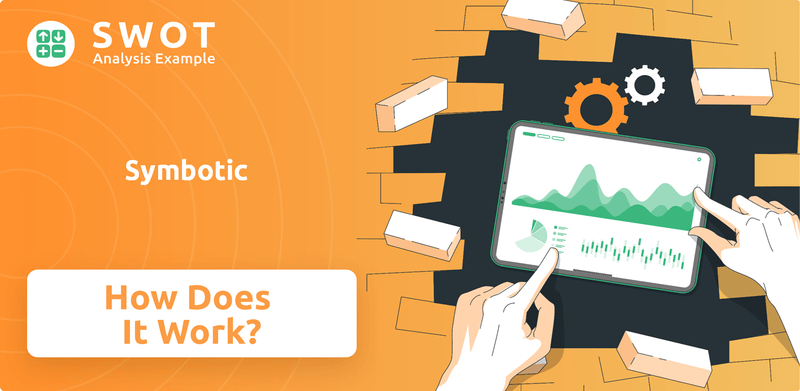
Symbotic's automated storage and retrieval system promises to optimize warehouse space and reduce operational costs, critical advantages in today's fast-paced e-commerce environment. By understanding Symbotic SWOT Analysis, investors and industry watchers can gain valuable insights into the growth potential of this technology. This exploration will uncover how Symbotic automation drives value and profitability, examining its core operations, strategic positioning, and impact on the future of logistics, including its warehouse robots and supply chain solutions.
What Are the Key Operations Driving Symbotic’s Success?
The core operations of the Symbotic Company center around designing, developing, and deploying advanced robotic automation systems. These systems are specifically tailored for warehouses and distribution centers. Their primary offering, the Symbotic System, integrates proprietary software, autonomous mobile robots (bots), and high-density storage structures to create a high-speed material handling solution.
This system is designed to serve various customer segments, including major retailers, wholesalers, and food and beverage distributors. These businesses seek significant improvements in their supply chain efficiency and accuracy. The operational process begins with a detailed analysis of a client's current warehouse infrastructure and logistical requirements.
Symbotic then designs and installs its modular system, incorporating its software platform for real-time inventory management and robot orchestration. The company's bots navigate the warehouse, picking, placing, and transporting inventory with speed and precision, reducing manual labor and human error. Ongoing services, including maintenance, support, and system upgrades, are provided to ensure optimal performance.
Symbotic offers comprehensive warehouse automation solutions. These solutions are designed to optimize warehouse operations. The systems are scalable and adaptable to different warehouse layouts and product mixes.
Symbotic provides advanced supply chain solutions. These solutions are aimed at improving efficiency and reducing costs. They help businesses streamline their logistics processes.
Robotics in logistics is a key focus for Symbotic. The company uses autonomous mobile robots to automate warehouse tasks. This leads to increased throughput and improved accuracy.
Symbotic's automated system streamlines the order fulfillment process. This includes picking, packing, and shipping. The technology enhances speed and reduces errors.
Symbotic automation offers several key benefits to its customers. These include increased throughput and reduced operational costs. The system also improves space utilization and inventory accuracy.
- Increased Throughput: The system significantly speeds up the movement of goods within a warehouse.
- Reduced Operational Costs: Automation lowers labor costs and minimizes errors.
- Optimized Space Utilization: The high-density storage structures maximize warehouse space.
- Enhanced Inventory Accuracy: Real-time inventory management reduces errors and improves tracking.
Symbotic SWOT Analysis
- Complete SWOT Breakdown
- Fully Customizable
- Editable in Excel & Word
- Professional Formatting
- Investor-Ready Format
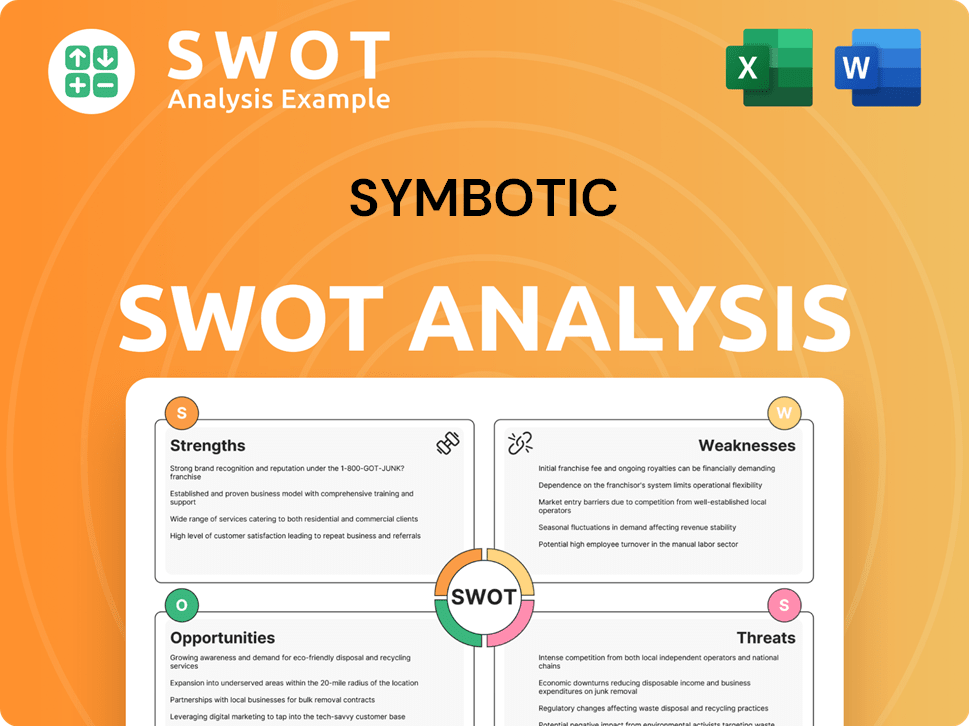
How Does Symbotic Make Money?
The Symbotic Company generates revenue through a multifaceted approach, primarily centered on its advanced warehouse automation systems. These systems encompass both the hardware and software solutions designed to optimize supply chain operations. The company's financial strategy is built on a foundation of system sales and recurring revenue streams.
A significant portion of Symbotic's revenue comes from the sale and installation of its automated warehouse systems. This includes the initial licensing of its software, which is crucial for the operation of its robotic solutions. Additionally, the company secures revenue through long-term service agreements and software subscriptions, ensuring a steady income flow.
In the first quarter of fiscal year 2024, Symbotic reported revenue of $369 million, demonstrating the continued growth in its core business. This growth is supported by the increasing demand for efficient supply chain solutions. The company's ability to secure long-term contracts is a key factor in its financial stability and future prospects.
Sales of automated warehouse systems, including hardware and initial software licensing, form a significant revenue stream. This initial investment by clients is a crucial part of Symbotic's business model.
Long-term service agreements provide a stable revenue stream. These agreements cover maintenance, support, and software updates, ensuring the systems' optimal performance.
Recurring software subscriptions contribute to predictable revenue. These subscriptions often include access to the latest software features and enhancements, ensuring that clients' systems remain up-to-date and efficient.
Potential for performance-based contracts, where compensation is tied to efficiency gains and cost savings. This innovative approach aligns Symbotic's interests with those of its clients, incentivizing optimal performance.
Scalability of solutions allowing for expansion within existing customer sites. This scalability allows Symbotic to grow with its clients, providing additional revenue opportunities as their needs evolve.
Potential for data analytics services derived from the operational insights gathered by its systems. This offers a new revenue stream by providing clients with valuable data-driven insights to further optimize their supply chain operations.
The Symbotic Company's revenue model is built on a combination of initial system sales and recurring revenue streams, creating a robust and sustainable financial structure. The company’s focus on long-term contracts and the critical role its technology plays in customer operations contribute to a strong revenue model. To understand more about the market, read about the Target Market of Symbotic.
- System sales, encompassing hardware and initial software licensing, form a significant revenue source.
- Long-term service agreements and software subscriptions provide a stable and predictable income stream.
- Performance-based contracts offer an innovative approach, aligning Symbotic’s compensation with client success.
- Scalability allows for expansion within existing customer sites, driving additional revenue.
- Data analytics services present a new avenue for revenue generation, leveraging operational insights.
Symbotic PESTLE Analysis
- Covers All 6 PESTLE Categories
- No Research Needed – Save Hours of Work
- Built by Experts, Trusted by Consultants
- Instant Download, Ready to Use
- 100% Editable, Fully Customizable
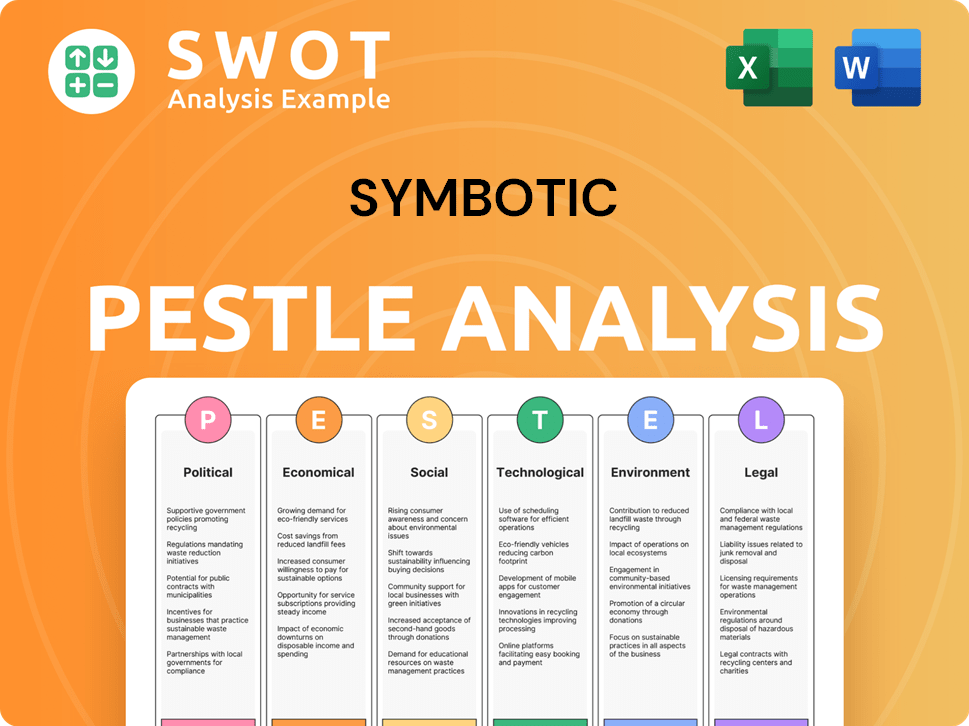
Which Strategic Decisions Have Shaped Symbotic’s Business Model?
The trajectory of the Symbotic Company has been marked by key milestones and strategic initiatives. A significant recent development is the expansion of its partnership with Walmart, announced in April 2024. This involves automating all 42 of Walmart's regional distribution centers, representing a major commitment and validation of Symbotic's technology.
Symbotic has also navigated operational challenges, including supply chain disruptions. The company invested in robust manufacturing processes and fostered strong supplier relationships. This ensured the timely delivery and deployment of its systems. These efforts have been crucial in maintaining momentum and meeting the growing demand for its warehouse automation solutions.
Symbotic's competitive edge is multifaceted, primarily due to its technological leadership. This is supported by proprietary software and hardware, enabling superior performance in speed, accuracy, and density compared to traditional warehouse automation solutions. Autonomous mobile robots and intelligent software orchestrate complex material handling tasks with remarkable efficiency. This provides a significant competitive advantage. The substantial investment from and ongoing partnership with large clients like Walmart also create significant barriers to entry for competitors, fostering an ecosystem effect. For more details on their expansion, consider reading about the Growth Strategy of Symbotic.
The partnership expansion with Walmart to automate all 42 regional distribution centers, announced in April 2024, is a major milestone. This commitment underscores the scalability and effectiveness of Symbotic's technology. The company has also focused on strengthening its supply chain to mitigate disruptions.
Symbotic has strategically invested in its technology and infrastructure to meet market demands. The company has expanded its service offerings and continuously innovates its technology. These moves are aimed at improving operational efficiency and customer satisfaction.
Symbotic's technological leadership, including its proprietary software and hardware, sets it apart. The company's ability to integrate seamlessly with existing infrastructure is another advantage. The ongoing partnership with major clients, such as Walmart, creates significant barriers to entry.
Symbotic adapts to market trends, such as the increasing demand for faster e-commerce fulfillment. The company is also addressing the growing labor shortages in logistics. Continuous innovation and expansion of services are key to meeting evolving market needs.
Symbotic Business Model Canvas
- Complete 9-Block Business Model Canvas
- Effortlessly Communicate Your Business Strategy
- Investor-Ready BMC Format
- 100% Editable and Customizable
- Clear and Structured Layout
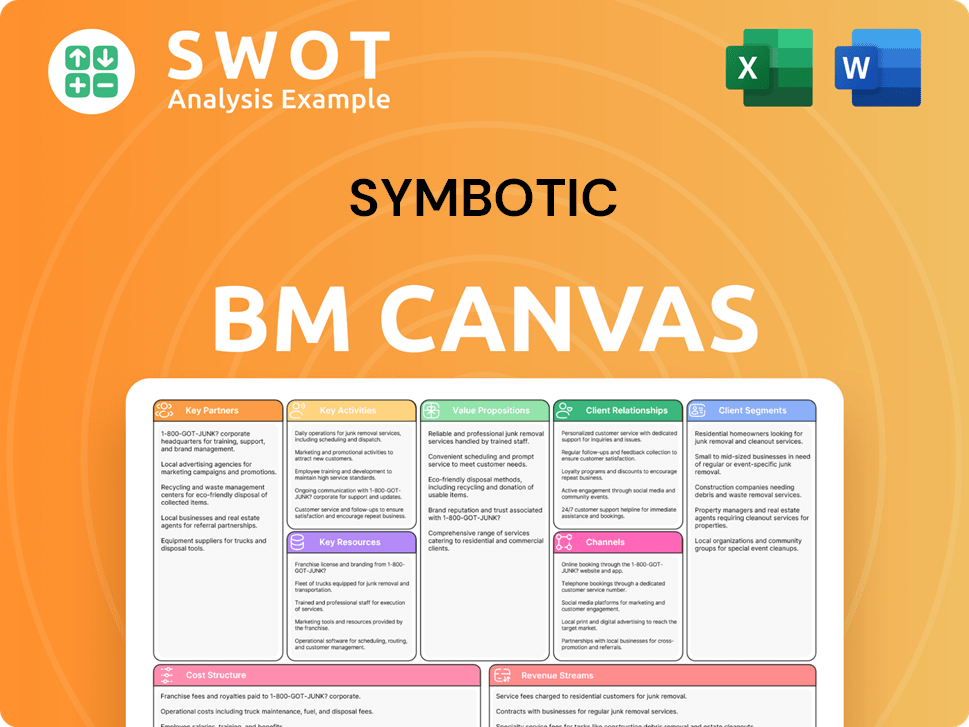
How Is Symbotic Positioning Itself for Continued Success?
The Symbotic Company holds a leading position in the rapidly expanding warehouse automation sector, particularly with its intelligent, robotic-driven solutions. Its strategic partnerships, including a significant one with Walmart, highlight its market share and customer loyalty among major retailers. Symbotic's technology is increasingly recognized as a benchmark for high-density, high-throughput automated storage and retrieval systems, giving it a strong competitive edge against traditional automation providers and emerging robotics companies.
However, Symbotic faces risks such as regulatory changes, competition, and economic downturns. Its future hinges on continued innovation, market expansion, and adapting to the evolving demands of modern supply chains. The company's focus on AI-powered software and robotic capabilities, along with its commitment to scaling operations, positions it to meet the growing demand for supply chain automation.
Symbotic is a key player in the warehouse automation industry, offering advanced supply chain solutions. Its automated storage and retrieval systems set a high standard. The company's strong relationships with major retailers, like Walmart, demonstrate its market influence and customer satisfaction.
Symbotic faces risks from changing regulations, new competitors, and economic fluctuations. Project execution risks and the complexity of large-scale automation systems also pose challenges. Shifts in consumer behavior and the retail sector could indirectly affect demand for its supply chain solutions.
Symbotic plans to invest in research and development to improve its AI and robotics. The company aims to expand its sales and deployment teams to enter new markets. It is also exploring applications beyond traditional warehousing to meet the accelerating demand for supply chain automation.
Symbotic's strategies include continuous innovation, market expansion, and adapting to supply chain needs. This involves enhancing its AI-powered software, expanding its sales teams, and exploring new applications. The company aims to deliver efficient automation solutions to solidify its position.
Symbotic's financial performance is closely tied to the growth of the e-commerce and retail sectors. The company's ability to secure and execute large-scale automation projects is crucial for its financial health. Market trends indicate a sustained demand for Symbotic automation, driven by the need for efficient supply chain solutions.
- Symbotic's revenue growth is expected to be robust, driven by increasing demand for its warehouse automation solutions.
- The company's customer base includes major retailers and distributors, providing a stable foundation for revenue generation.
- Symbotic is focused on expanding its market reach and enhancing its technology to maintain its competitive edge.
- The company's investments in R&D and strategic partnerships are key to its long-term growth strategy.
Symbotic Porter's Five Forces Analysis
- Covers All 5 Competitive Forces in Detail
- Structured for Consultants, Students, and Founders
- 100% Editable in Microsoft Word & Excel
- Instant Digital Download – Use Immediately
- Compatible with Mac & PC – Fully Unlocked
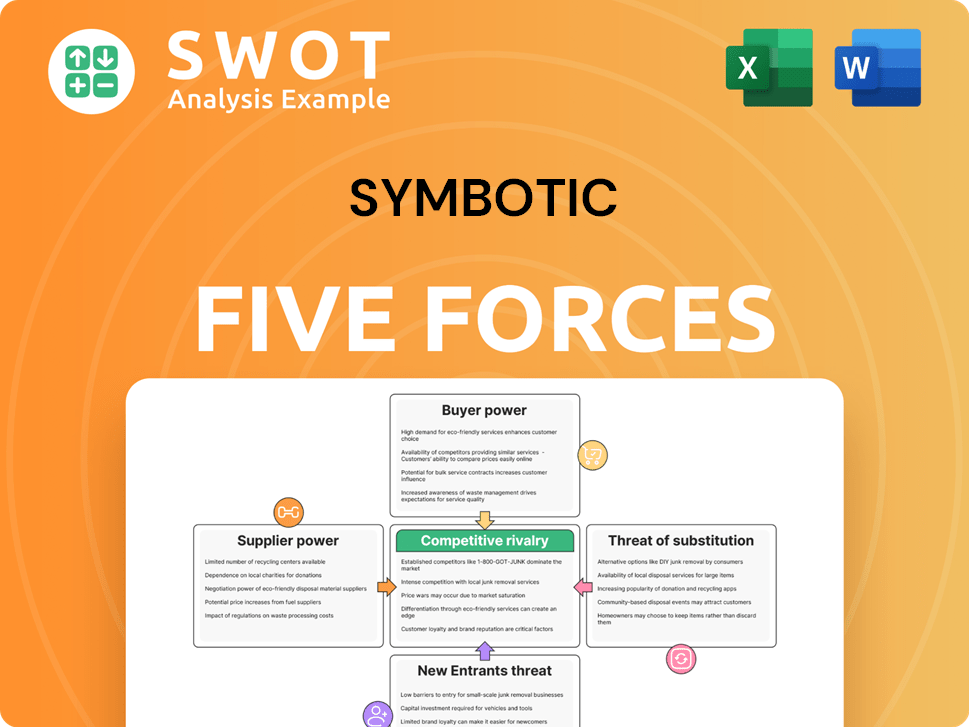
Related Blogs
- What are Mission Vision & Core Values of Symbotic Company?
- What is Competitive Landscape of Symbotic Company?
- What is Growth Strategy and Future Prospects of Symbotic Company?
- What is Sales and Marketing Strategy of Symbotic Company?
- What is Brief History of Symbotic Company?
- Who Owns Symbotic Company?
- What is Customer Demographics and Target Market of Symbotic Company?
Disclaimer
All information, articles, and product details provided on this website are for general informational and educational purposes only. We do not claim any ownership over, nor do we intend to infringe upon, any trademarks, copyrights, logos, brand names, or other intellectual property mentioned or depicted on this site. Such intellectual property remains the property of its respective owners, and any references here are made solely for identification or informational purposes, without implying any affiliation, endorsement, or partnership.
We make no representations or warranties, express or implied, regarding the accuracy, completeness, or suitability of any content or products presented. Nothing on this website should be construed as legal, tax, investment, financial, medical, or other professional advice. In addition, no part of this site—including articles or product references—constitutes a solicitation, recommendation, endorsement, advertisement, or offer to buy or sell any securities, franchises, or other financial instruments, particularly in jurisdictions where such activity would be unlawful.
All content is of a general nature and may not address the specific circumstances of any individual or entity. It is not a substitute for professional advice or services. Any actions you take based on the information provided here are strictly at your own risk. You accept full responsibility for any decisions or outcomes arising from your use of this website and agree to release us from any liability in connection with your use of, or reliance upon, the content or products found herein.